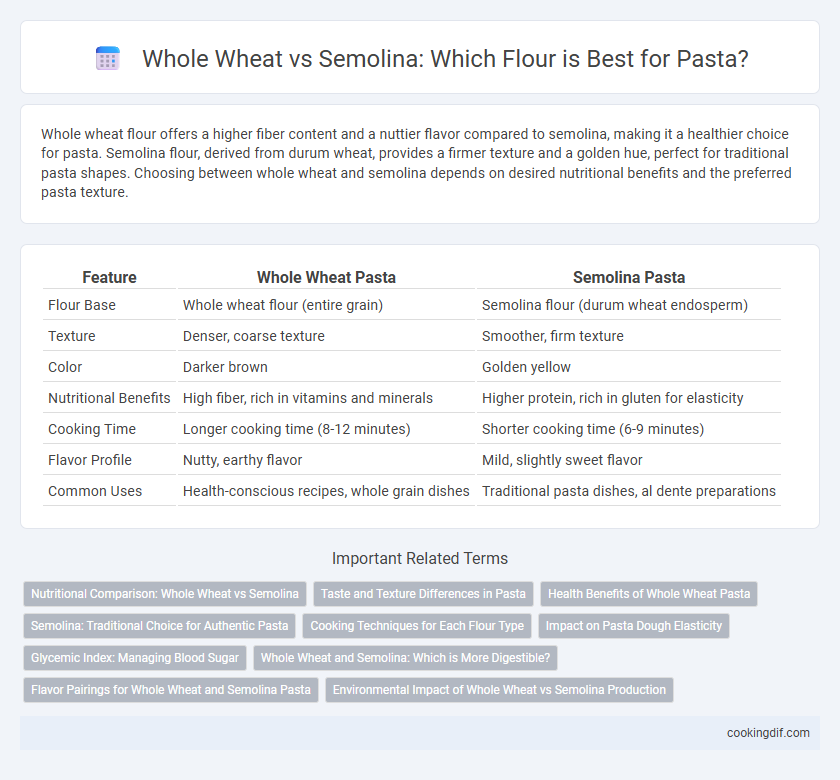Whole wheat flour offers a higher fiber content and a nuttier flavor compared to semolina, making it a healthier choice for pasta. Semolina flour, derived from durum wheat, provides a firmer texture and a golden hue, perfect for traditional pasta shapes. Choosing between whole wheat and semolina depends on desired nutritional benefits and the preferred pasta texture.
Table of Comparison
| Feature | Whole Wheat Pasta | Semolina Pasta |
|---|---|---|
| Flour Base | Whole wheat flour (entire grain) | Semolina flour (durum wheat endosperm) |
| Texture | Denser, coarse texture | Smoother, firm texture |
| Color | Darker brown | Golden yellow |
| Nutritional Benefits | High fiber, rich in vitamins and minerals | Higher protein, rich in gluten for elasticity |
| Cooking Time | Longer cooking time (8-12 minutes) | Shorter cooking time (6-9 minutes) |
| Flavor Profile | Nutty, earthy flavor | Mild, slightly sweet flavor |
| Common Uses | Health-conscious recipes, whole grain dishes | Traditional pasta dishes, al dente preparations |
Nutritional Comparison: Whole Wheat vs Semolina
Whole wheat flour contains higher fiber content, essential vitamins like B-complex, and minerals such as iron and magnesium compared to semolina, which is made from refined durum wheat and offers more protein but fewer micronutrients. Semolina flour has a coarser texture and provides more gluten, making pasta firmer and chewier, but it lacks the antioxidant properties and complex carbohydrates found in whole wheat. Choosing whole wheat pasta supports better digestion and sustained energy release, while semolina pasta is preferred for its texture and traditional culinary profile.
Taste and Texture Differences in Pasta
Whole wheat flour gives pasta a nuttier, earthier flavor with a denser, chewier texture due to its higher fiber content and bran presence. Semolina flour, derived from durum wheat, produces pasta with a firmer bite and smoother surface, offering a slightly sweet, mild taste ideal for traditional Italian dishes. The choice between whole wheat and semolina significantly impacts pasta's mouthfeel and flavor profile, influencing cooking time and sauce absorption.
Health Benefits of Whole Wheat Pasta
Whole wheat pasta offers higher fiber content compared to semolina pasta, promoting better digestion and sustained energy release. It contains more essential nutrients such as vitamins B and E, iron, and magnesium, supporting cardiovascular health and improved metabolism. The lower glycemic index of whole wheat pasta helps regulate blood sugar levels, making it a healthier choice for managing diabetes and weight control.
Semolina: Traditional Choice for Authentic Pasta
Semolina flour, derived from durum wheat, remains the traditional choice for authentic pasta due to its high protein and gluten content, which ensures a firm texture and excellent bite. Its coarse grind enhances pasta's ability to hold sauces and retain shape during cooking, making it ideal for classic Italian dishes like spaghetti and penne. Compared to whole wheat flour, semolina delivers a lighter color and smoother texture while preserving the rich, nutty flavor prized in regional pasta recipes.
Cooking Techniques for Each Flour Type
Whole wheat pasta requires longer boiling times and careful monitoring to prevent it from becoming mushy due to its higher fiber content and denser texture. Semolina pasta cooks faster with a firm al dente bite because of its high protein and gluten content, making it ideal for traditional Italian dishes. Adjusting water temperature and cooking duration is crucial to optimize the texture and flavor when working with each flour type.
Impact on Pasta Dough Elasticity
Whole wheat flour increases fiber content but reduces gluten strength, resulting in less elastic pasta dough compared to semolina. Semolina flour, rich in protein and gluten-forming properties, creates a firmer, more elastic dough ideal for traditional pasta shapes. Choosing semolina enhances dough elasticity, improving texture and cooking performance.
Glycemic Index: Managing Blood Sugar
Whole wheat flour has a lower glycemic index (GI) compared to semolina, contributing to slower blood sugar spikes and improved glycemic control. Semolina, made from durum wheat, typically exhibits a higher GI, causing quicker glucose absorption in the bloodstream. Choosing whole wheat pasta supports better management of blood sugar levels and can aid in preventing insulin resistance and type 2 diabetes.
Whole Wheat and Semolina: Which is More Digestible?
Whole wheat flour contains more fiber and nutrients compared to semolina, contributing to slower digestion but improved gut health. Semolina, made from durum wheat, is higher in gluten and starch, making it easier to break down and absorb quickly. Choosing between whole wheat and semolina pasta depends on individual digestive tolerance and nutritional priorities for fiber intake versus rapid energy release.
Flavor Pairings for Whole Wheat and Semolina Pasta
Whole wheat pasta offers a nutty, robust flavor that pairs well with earthy vegetables like mushrooms, spinach, and roasted root vegetables, as well as rich sauces such as tomato basil and garlic olive oil. Semolina pasta has a mild, slightly sweet taste that complements lighter ingredients like seafood, fresh tomatoes, basil pesto, and delicate cream sauces. Selecting whole wheat or semolina pasta depends on matching the pasta's depth and texture with complementary ingredients to enhance the overall dish.
Environmental Impact of Whole Wheat vs Semolina Production
Whole wheat pasta production generally has a lower environmental impact compared to semolina because whole wheat utilizes the entire grain, reducing waste and enhancing resource efficiency. Semolina, derived from durum wheat endosperm, requires more intensive processing and higher water consumption, increasing its carbon footprint. Cultivating whole wheat also promotes soil health through crop rotation practices, contributing to sustainable agriculture.
whole wheat vs semolina for flour base Infographic

 cookingdif.com
cookingdif.com